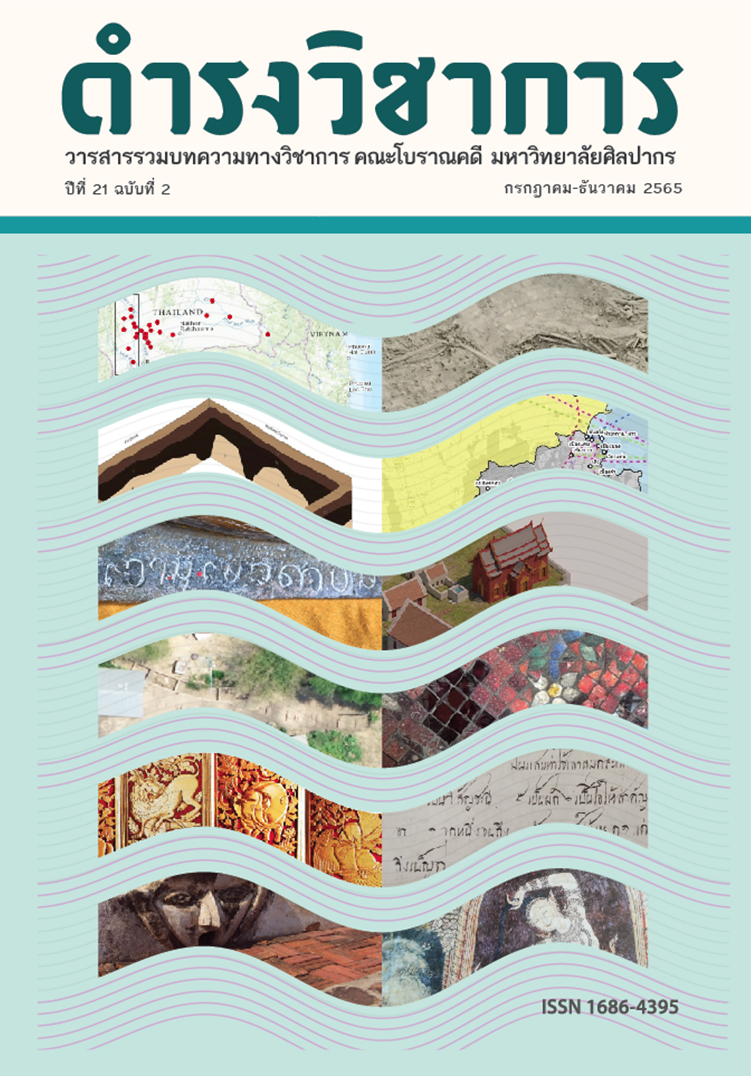The Ancient Iron Smelting Technology at Ban Na Tum Archaeological Site, Ancient Muaeng Long Town, Phrae Province, Thailand
Keywords:
Maung Long, Iron, Iron smelting, direct process smelting and tribute paymentAbstract
This article aims to provide an Archaeometallurgical, Archaeological, and Historical study of Ban Na Tum Archaeological Site, which was Maung Long’s iron smelting site from 18th – 20th century. The objective of the article is to reconstruct the ancient iron smelting process (Chaîne opératoire of iron ingot production) by using archaeometallurgical data, archaeological evidence, and historical record.
The result demonstrates that Ban Na Tum’s smelting furnace structure is 80 cm high and takes a shaft furnace shape with a double piston bellow system. The smelting technique is a “Direct Process” and requires higher temperatures of approximately 1,175 – 1,200 celsius degrees. The iron ore is hematite, which was mined at Doi Lek Mountain. The ratio of iron ore and fuel is 1: 2. The iron ingot is both the annual tribute payment to the ruler of Muang Lampang and the material used to produce iron equipment in Muang Long. Muang Long could produce at least 2.4 tons of iron ingot per year. The iron of Maung Long is of good quality. The Lanna people always say “The best quality iron is from Muang Long! The best quality gold is from Maung Phayao!”. Moreover, in some Northern Thailand literature, such as “The poem of the ruler of Maung Phrae’s palace celebration; Sriwijaya, 1832 A.D.”, describes iron from Maung Long as not only strong but also sacred.
References
ภาษาไทย
จตุรพร เทียมทินกฤต และพลพยุหะ ไชยรส, 2562. รายงานการสำรวจและขุดค้นทางโบราณคดีภาคสนามเบื้องต้นในแหล่งโบราณคดีบ้านนาตุ้ม ตำบลบ่อเหล็กลอง อำเภอลอง จังหวัดแพร่. เชียงใหม่: สำนักศิลปากรที่ 7 เชียงใหม่ กรมศิลปากร. เอกสารอัดสำเนา.
ปรีดี พิศภูมิวิถี และคณะ, 2561. ฝรั่งในล้านนา. กรุงเทพฯ: กรมศิลปากร.
พจนีย์ ไพศาลตันติวงศ์, 2546. คุณภาพของแร่เหล็กจากแหล่งต่างๆ ในประเทศไทย. กรุงเทพฯ: กองวิเคราะห์และตรวจสอบทรัพยากรธรณี.
พลพยุหะ ไชยรส, 2561, รายงานการสำรวจทางโบราณคดีแหล่งโลหกรรมสมัยโบราณในบริเวณแอ่งที่ราบลองวังชิ้น จังหวัดแพร่ ตามหลักกระบวนงานโบราณโลหะวิทยา (Archaeometallurgy). เชียงใหม่: สำนักศิลปากรที่ 7 เชียงใหม่ กรมศิลปากร. เอกสารอัดสำเนา.
ภูเดช แสนสา, 2554. ประวัติศาสตร์เมืองลอง หัวเมืองบริวารในล้านนาประเทศ. เชียงใหม่: นพบุรีการ พิมพ์.
สรัสวดี อ๋องสกุล, 2546. พื้นเมืองเชียงแสน. กรุงเทพฯ: อมรินทร์.
สุรพล นาถะพินธุ, 2550. รากเหง้าบรรพชนคนไทย: พัฒนาการทางวัฒนธรรมก่อนประวัติศาสตร์. กรุงเทพฯ: มติชน.
อุดม รุ่งเรืองศรี, 2524. กำสรวลพระยาพรหม: คร่าวสี่บทและคำจ่มของพระยาพรหมโวหาร. เชียงใหม่: มหาวิทยาลัยเชียงใหม่.
จดหมายเหตุ
“พระพรหมบริรักษ์กราบทูลสมเด็จฯ ซึ่งสำเร็จราชการกรมมหาดไทยรายงานข้อราชการที่ออกไปเมืองลอง.” กจช.ร.5ม ร5 นก/33(20). สำนักหอจดหมายเหตุแห่งชาติ.
“รายงานเสด็จตรวจทางรถไฟสายเหนือของกรมขุนกำแพงเพชร 13 กรกฎาคม 2461.”, พ.ศ. 2461. กจช.ร6 คค.5.3/8. สำนักหอจดหมายเหตุแห่งชาติ.
ภาษาอังกฤษ
Bock C.A., 1884. Temples and elephants: The narrative of a journal of exporation through Upper Siam and Lao. New York: Cornell University Library.
Charlton M., 2010. “Explaining the evolution of ironmaking recipes – An example from northwest Wales.” Journal of Anthropological Archaeology 29: 357.
Évrard O. et al., 2016. “Of myths and metallurgy: Archaeological and ethnological approaches to upland iron production in 9th century CE northwest Laos.” Journal of Southeast Asian Studies 47(1): 119.
Miller H. M.-L., 2009. Archaeological approaches to technology. California: Left Coast Press Inc.
Tylecote R.F., 1992. A history of metallurgy. 2nd edition. London: The institute of material.
United Department of State and Thai Royal Department of Mines, 1975. “Geologic reconnaissance of the mineral deposit of Thailand.” Geological Investigation Bulletin 984: 75-76.
Downloads
Published
Issue
Section
License
Copyright (c) 2022 Damrong Journal of The Faculty of Archaeology Silpakorn University

This work is licensed under a Creative Commons Attribution-NonCommercial-NoDerivatives 4.0 International License.
บทความนี้เป็นผลงานของข้าพเจ้าแต่เพียงผู้เดียว และ/หรือเป็นผลงานของข้าพเจ้าและผู้ร่วมงาน ตามชื่อที่ระบุในบทความจริง และเป็นผลงานที่มิได้ถูกนำเสนอหรือตีพิมพ์ที่ใดมาก่อน





